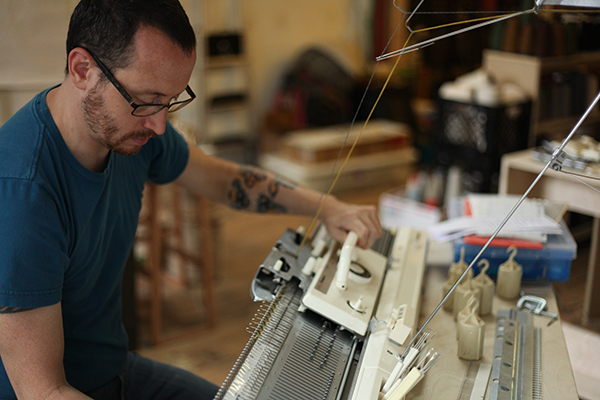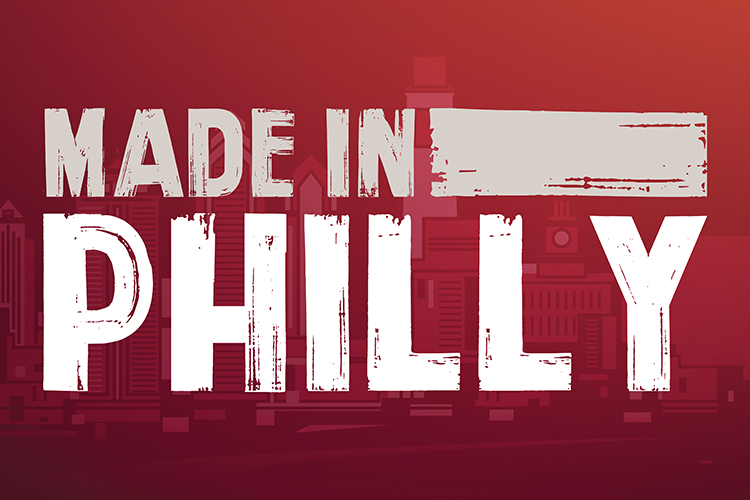On the Make
by Alex Jones
Janell Wysock designs and makes knitted and woven garments. For most of the year, she’s a one-woman shop, using a combination of machine knitting and by-hand techniques to create one-of-a-kind pieces. However, demand from local and regional boutiques outstrips her ability to produce finished garments, and cash flow issues prevent her from hiring additional craftspeople to help fill orders.
“My scale now is when I caan afford to have someone help me knit and do the piecework, I do that a couple times a year,” says Wysock. “Otherwise, I’m doing it, and I don’t have time for design.” If Wysock had access to a shared knitting mill in the city where she could place small orders for production runs at a lower cost, she’d be able to sell more products to retailers eager to stock her unique creations.
Wysock is also a member of the Community of Philadelphia Makers. Maker, designer and University of the Arts professor Andrew Dahlgren, the group’s leader, hopes to support a new generation of making in Philadelphia. He believes that for businesses like Wysock’s to expand, makers’ needs must be met—and the needs of different businesses are diverse.
“[We’re] attempting to understand what this new generation of makers is looking to do, and then finding the ways of supporting that,” says Dahlgren, who has worked with metals, wood and textiles. Dahlgren recently launched a Community Supported Manufacturing program in which customers pay up front for the production of a quarterly delivery of Philly-made knitted garments and housewares, a riff on the community-supported agriculture concept.
Rather than streaming into factories wearing hard hats and carrying lunch pails, these makers are working out of their apartments, artists’ studios or shared incubator spaces like the Clay Studio or NextFab, producing small batches of high-quality products that are sold locally. Some learned their craft in art school, while others are hobby makers hoping to one day support themselves through work they’re passionate about. Some design and make their own products, while others are designers in need of production facilities or skilled labor.
One of the first steps to organizing this sector is defining what the maker community is. For Dahlgren, “Our target community is somebody who makes things for people or for themselves, and the making activity requires an understanding of materials, technology and people.”
Next, Dahlgren hopes to build a membership base of local makers and fundraise to create an online database that would collect information on makers and resources. The data will help CPM, the City of Philadelphia, potential partner organizations, and investors address needs and opportunities of the making and manufacturing sector. Makers would be able to look to the database to meet their needs for raw materials, design, production help and other support.
“Makers want to find someone to make for,” Dahlgren says. “Designers are more and more interested in local manufacturing [and] smaller batch manufacturing, and right now that tool to connect the two doesn’t exist.”
Michael Cooper, director of the City of Philadelphia’s Office of Manufacturing and Industry, is also eager to get numbers on the current maker movement in Philly in order to learn how the city can better support these enterprises. “I’m interested in understanding and quantifying the sector a little bit more locally, so that we can develop some sense of policies and programs that actually meet that need,” Cooper says, “[with the] understanding that some of [these businesses] will grow, and we want them to grow in Philadelphia.”
Andrew Jevremovic, CPM member and owner of Octo Studio, works with Pennsylvania hardwood and New Jersey-sourced steel to create sleek, dramatic sculptures, furniture and interiors. Since the 2008 recession, Octo has been hit with unexpected small business taxes from a city looking to increase revenue; dealing with a downturn in business combined with burdensome taxes has been a challenge. To keep business afloat, Jevremovic has turned to more business-to-business work, designing and manufacturing signage and interiors for hip spots like Fishtown’s Kraftwork and Bing Bing Dim Sum in East Passyunk.
What Jevremovic thinks would help makers like him—whose enterprise requires highly specialized skills and equipment, appropriate space and customers willing to pay a premium—is a rebranding of the city as the nation’s source for top-quality products once again.
“What people like myself really need in Philadelphia is someone helping to get rid of this stigma that buyers in Philadelphia have about things that are made in Philadelphia,” Jevremovic says. Philly customers in the market for items of a similar quality to those produced at Octo Studio—ready to pay up to $50,000 for a dining room table—go to New York to shop because of its reputation for luxury goods, something that Philly doesn’t have.
Aside from specialized needs like equipment and skilled labor, the maker community needs the same support that all small businesses do. Morris Levin is a consultant with Elysian Fields, which provides business development and other support to all types of small businesses in Philadelphia—including navigating requirements of the Affordable Care Act and the notorious bureaucracy of the city’s Department of Licenses and Inspections. “[Streamlining L&I] would make a huge difference,” Levin says. “Even before you talk about city programs and city financing and special tax breaks. I’m probably in the minority, but I would just set all that aside and really hit the basics.”
In addition to assessing the maker community and working to meet its diverse needs, Dahlgren plans to hold networking events for makers and potential customers that will help connect supply and demand more efficiently. He’s also hoping that strategic partnerships with schools and other educational
organizations will reintroduce kids and parents to the idea that making and manufacturing can be a viable career path.
“There’s been a break between the historical blue collar families working in factories and a new generation of makers,” says Dahlgren. “I think if the new makers are successful at expanding their businesses in a way I hope they are, I think we’ll see a new appreciation for that work again.”










